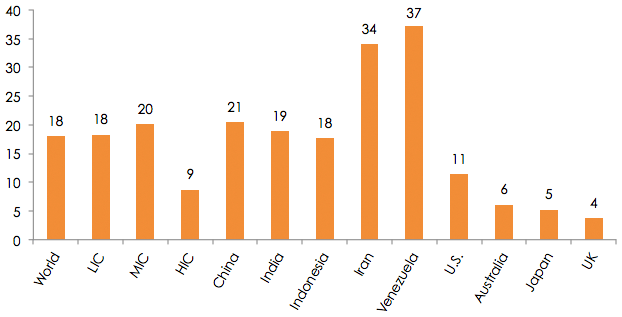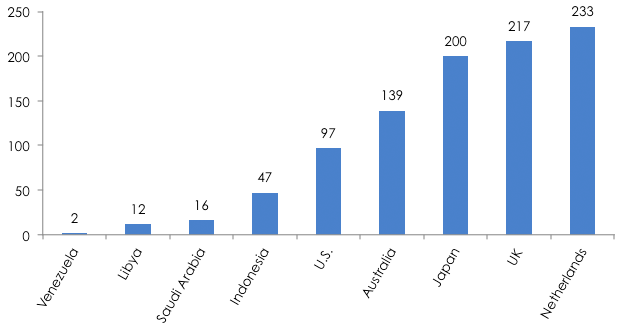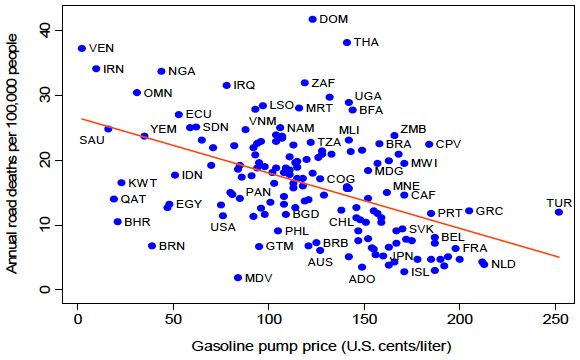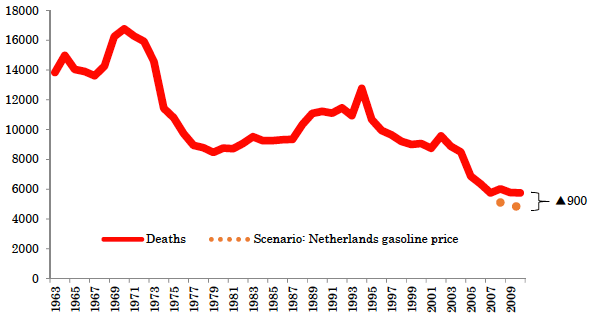Warning by Dr. Uzawa
In September 2014, Dr. Hirofumi Uzawa passed away. As a theoretical economist, he left behind great academic accomplishments such as the two-sector growth model and the theory of disequilibrium. An economist of rare qualities, Dr. Uzawa was actively engaged in various social movements and left a significant mark as a social activist. Published in 1974, his book Jidosha no Shaiteki Hiyo [The Social Costs of Automobiles] sounded an alarm for, and aroused significant controversy in the Japanese society at the time, warning that the basic rights of people are being seriously infringed upon due to an unrestricted increase in the number of cars. In this book, Dr. Uzawa pointed out that the unduly low cost of driving cars is the root of all evil and called for internalizing the social costs involved. He wrote as follows:
"Specifically, the social costs of automobiles are incurred in such forms as road accidents, crimes, pollution, and environmental destruction. Each of them is an infringement of people's basic rights, such as good health and road safety for pedestrians, and often causes irreversible damage to the people. Against the sheer size of the social costs involved, those receiving the benefits of automobiles are paying only a fractional part of the costs.... When those beneficiaries from the use of automobiles bear a social cost, the most efficient distribution of social overhead capital can be achieved, whereby it will become possible for motor vehicles to operate without infringing on the basic rights of citizens." (Uzawa 1974, pp.170-172)
The purpose of this article is to consider the internalization of social costs of automobiles, as advocated by Dr. Uzawa four decades ago, in terms of its significance in promoting road safety in today's international community. Surprisingly, the United Nations' Decade of Action for Road Safety 2011-2020 lacks the perspective of internalizing social costs. In this article, I would like to show that reducing gasoline subsidies and imposing additional taxes on gasoline consumption are effective policy tools for reducing the number of road deaths. In particular, I will argue that policy reform in countries providing enormous fossil fuel subsidies should be included as an important agenda item for discussion in order to achieve the road safety goals set forth by the United Nations.
Road accidents as a global issue
In Japan, the number of road fatalities has been on a consistent decline since the 1990s. The number of deaths in 2013 totaled 4,373, compared to about 11,000 in 1991. Such a declining trend in road deaths is a common phenomenon observed across developed countries. However, in terms of global numbers, road fatalities have been continuing to rise. The largest factor behind this is motorization in developing countries. As a result of remarkable economic growth since the 1980s, the level of people's income rose significantly in developing countries, enabling more people to afford cars and live in affluence. At the same time, however, they are now seeing a rise in social costs resulting from the rapid increase of automobiles on the streets, just as Japan and other developed countries had experienced in the past. Motorization in developing countries, China and India in particular, is taking place on an unprecedented scale, and, thus, the accompanying social costs are enormous.
Among all, road accidents are an issue that is extremely serious and requires urgent action. The Global Plan for the Decade of Action for Road Safety 2011-2020 , prepared by the World Health Organization (WHO), alerts us to the stark reality.
- Each year, nearly 1.3 million people die as a result of a road traffic collisions--more than 3,000 deaths each day--and approximately 90% of them are in low- and middle-income countries.
- Road traffic injuries are the ninth largest cause of death for the entire population and the top cause of death for those aged 15-29.
- Each year, 50 million people sustain injuries from road traffic collisions.
- The number of road deaths is predicted to reach 2.4 million in 2030 (if no action is taken).
- The economic loss caused by motor vehicle crashes is estimated to be about $500 billion per year or between 1% and 3% of the respective gross national product (GNP) of countries across the world
Recognizing this stark reality, the United Nations General Assembly in March 2010 proclaimed the period 2011-2020 as the "Decade of Action for Road Safety," and confirmed that counties around the world will act proactively on national, regional, and global levels to reduce the number of road deaths.
Higher road fatalities in low- and middle-income countries

How high are road fatalities in developing countries? Figure 1 shows an international comparison of road fatality rates, i.e., the number of road fatalities per 100,000 of population. The first bar from the left represents the road fatality rate for the entire world (18). The second, third, and fourth bars provide a comparison of three groups of countries classified by income level. We can see that the road fatality rate is higher in low-income countries (LIC) at 18 and middle-income countries (MIC) at 20, and lower in high-income countries (HIC) at nine. We can clearly see the same tendency in a country-by-country comparison. The road fatality rates for China, India, Indonesia, Iran, and Venezuela (low- and middle-income countries) are higher than those for the United States, Australia, Japan, and the United Kingdom (high-income countries). Interestingly, the road fatality rates vary significantly even among countries belonging to the same income group. For instance, among the low- and middle-income countries, Iran and Venezuela stood out with fatality rates of 34 and 37 respectively, substantially higher than those of their peers. Likewise, the road fatality rate of the United States (11) sticks out in the high-income group.
What are the factors behind those differences across countries in the same income group? Our focus is on differences in gasoline prices across countries. In other words, we thought that if the low cost of driving cars (gasoline prices) is the source of social costs as Dr. Uzawa pointed out, we could probably explain cross-country differences in the road fatality rate by the differences in gasoline prices. Although there are some prior studies on gasoline prices and road accidents (e.g., Grabowski & Morrisey 2004), all of them focus on the United States. This article is the first attempt to analyze them on a global scale including low- and middle-income countries.
Lower gasoline prices in low- and middle-income countries

Figure 2 shows retail prices for gasoline in major countries in 2012. First of all, we can see the general tendency for people in higher-income countries to pay more for driving cars. For instance, while Venezuelans pay only two cents per liter of gasoline, Dutch pay 233 cents. Interestingly, there seems to be a negative correlation between the road fatality rate and the level of gasoline prices. Among low- and middle-income countries, Indonesia, whose road fatality rate was 18 in 2010, had relatively high gasoline prices at 47 cents per liter in 2012, far more expensive than in Venezuela where the road fatality rate was 37. Likewise, among high-income countries, the United States had the cheapest gasoline at 97 cents per liter, followed by Australia (139 cents), Japan (200 cents), and the United Kingdom (217 cents), which is the exact opposite of the order in terms of the road fatality rate (Figure 1).
It is known that differences in gasoline prices across countries are chiefly attributable to differences in subsidies and taxes (Rietveld and Woudenberg 2005). Retail gasoline prices tend to be low in developing countries because the governments of those countries provide massive amounts of subsidies to consumers in order to avoid political instability. In other words, many developing countries are doing the exact opposite of internalizing the social costs of automobiles. Meanwhile, higher gasoline prices in high-income countries are due to heavy fuel taxes. For instance, roughly 40% of what people pay for gasoline in Japan is taxes and the percentage is even higher in the United Kingdom at 62%. Relatively low gasoline prices in the United States, as compared to other high-income countries, are due to the lower fuel tax rate of 12%.
Correlation between road fatality rates and gasoline prices

The discussion to this point has suggested the existence of a negative correlation between road fatality rates and gasoline prices. Figure 3 shows that this argument can be more generalized. It plots the number of road fatalities per 100,000 people in 2010 against gasoline prices for each of the 153 countries covered. Countries with higher gasoline prices--e.g., Turkey (abbreviated as TUR in the figure) and the Netherlands (NLD)--tend to have lower road fatality rates, whereas those with lower gasoline prices--e.g., Venezuela (VEN), Iran (IRN), and Saudi Arabia (SAU)--tend to have higher road fatality rates. At the same time, however, Figure 3 also shows that gasoline prices alone cannot explain differences in road fatality rates across countries because significant deviations are observed even between countries with the same level of gasoline prices. For instance, the Dominican Republic (DOM) and Australia (AUS) have the same level of gasoline prices but their road fatality rates differ greatly. This suggests that other factors, such as income levels, infrastructure conditions, the severity and effectiveness of traffic laws and regulations, and ethical standards, are also important explanatory variables.
Impact of changes in gasoline prices on road fatalities
Here, I would like to report briefly on findings from our empirical study, Burke & Nishitateno "Gasoline Prices and Road Fatalities: International Evidence" (forthcoming in Economic Inquiry ). In order to identify how changes in gasoline prices impact road accidents, we performed a regression analysis based on the following estimated equation:
ln D c,t = α + β 1 ln G c,t + β 2 ln Y c,t + β 3 ln P c,t + γ X c,t + δ c + ω t + ε c,t
where c and t denote country and year respectively, while prefix "ln" indicates that variables are expressed in natural logarithms. The response variable ( D ) is the number of road death. Explanatory variables are gasoline prices ( G ), gross domestic product ( Y ), population ( P ), and other factors ( X ). Other factors include the penetration of automobiles, demographic structure, traffic regulations, population density, the availability of public transportation, and infrastructure conditions. Meanwhile, δ and ω denote country- and year-specific fixed effects respectively, whereas ε is the error term. The sample period is from 1991 through 2010 (each year) and a total of 144 countries are covered. Readers interested in the robustness of our findings or in the definitions, measures, data sources, endogeneity of, and estimation methods for the variables are advised to read our forthcoming paper (Burke & Nishitateno). For a detailed explanation of the instrumental variable method used in our study, see Burke & Nishitateno (2013).
Our empirical study found that the long-run gasoline price elasticity of road deaths falls within the range between -0.3 and -0.6. In other words, a 10% increase in gasoline prices would reduce the number of road deaths by 3% to 6%. This suggests that gasoline pricing policies by means of subsidies and taxation could change the cost of driving cars, thereby having an impact on people's incentives. Higher costs of driving cars would prompt people to reduce travel distance or use public transportation instead of cars, resulting in reduced risk of road accidents.
Policy implications
Based on our empirical research findings above, I would like to discuss to what extent road deaths could be reduced by cutting back on subsidizing gasoline consumption and raising gasoline taxes.
1. Implications for gasoline subsidy reform
| Country |
Gasoline pump price (U.S. cents per liter) |
Estimated road deaths avoided if gasoline price were equal to the level in the United States |
|---|---|---|
| Venezuela | 2 | 5,000 |
| Iran | 10 | 10,600 |
| Saudi Arabia | 16 | 2,700 |
| Libya | 17 | 584 |
| Qatar | 19 | 158 |
| Bahrain | 21 | 103 |
| Turkmenistan | 22 | 382 |
| Kuwait | 23 | 202 |
| Oman | 31 | 144 |
| Algeria | 32 | 1,700 |
| Yemen | 35 | 1,000 |
| Brunei Darussalam | 39 | 15 |
| Nigeria | 44 | 4,200 |
| United Arab Emirates | 47 | 210 |
| Egypt | 48 | 1,800 |
| Indonesia | 51 | 4,500 |
| Ecuador | 53 | 259 |
| Malaysia | 59 | 345 |
| Sudan | 62 | 331 |
| Angola | 65 | 141 |
| Bolivia | 70 | 38 |
| Kazakhstan | 71 | 51 |
| Azerbaijan | 75 | 6 |
| Total for 23 countries | 35,000 |
According to estimates by the International Monetary Fund (IMF), countries around the world together provide a total of 200 billion dollars in fossil fuel subsidies every year. By removing all of those subsidies, how many road fatalities could be avoided? Here, we regard those countries with average gasoline prices below the U.S. level as gasoline-subsidizing countries. The U.S. retail gasoline price of 76 cents per liter includes 13 cents in taxes (no subsidies), which could be considered as the minimum amount of taxes required to finance necessary investment in transport infrastructure and cover externality costs (GIZ 2012). In other words, any amount by which a country's retail gasoline price falls below the U.S. level is considered to be the amount of (hypothetical) subsidies per liter of gasoline. Based on this definition, 23 countries are regarded as subsidizing countries, which together have a population of approximately 800 million. Table 1 shows how many road deaths could be avoided in those countries by raising retail gasoline prices to the U.S. level (i.e., eliminating subsidies). It indicates that 35,000 road deaths (3% of global road fatalities) could be avoided each year by the removal of subsidies. The impact of subsidy elimination would be greatest in Iran (with 10,600 lives expected to be saved per year), followed by Venezuela (5,000), Indonesia (4,500), Nigeria (4,200), Saudi Arabia (2,700), Egypt (1,800), Algeria (1,700), and Yemen (1,000).
2. Implications for the effects of higher gasoline taxes

Figure 4 shows changes in the number of road deaths in the United States over the past 50 years. While road fatalities have been on a gradual decline on a long term basis, as many as 33,000 Americans lost their lives in traffic accidents in 2011. The United States dwarfs other high-income countries not only in the absolute number of road fatalities but also in the road fatality rate (Figure 1). In Burke & Nishitateno (forthcoming), we show that the lower cost of driving cars in the United States is one reason. Indeed, U.S. gasoline prices (76 cents per liter) are the lowest among the member countries of the Organisation for Economic Co-operation and Development (OECD). As discussed earlier, this is due to lower gasoline taxes (13 cents per liter) in the United States. Then, how many American lives could be saved if U.S. gasoline prices are raised to the UK level (192 cents per liter)? Our estimates show that 8,500 people would be spared each year (Figure 4). The figure is equivalent to 26% of annual road deaths in the United States, showing just how much we could make a difference by raising gasoline taxes.

Now, let's take a look at Japan. Figure 5 shows the changes in the number of road deaths in Japan over the past 50 years. By raising gasoline prices to the level of the Netherlands (213 cents per liter), how many Japanese lives could be saved per year? Our estimates show that 900 road deaths (Figure 5), or 20% of annual road fatalities, could be avoided. Conversely, lowering Japanese gasoline prices to the U.S. level (76 cents per liter) would result in 3,000 additional road deaths each year.
Conclusion
The purpose of this article was to look into the implications of internalizing social cost automobiles resulting from more people driving cars in terms of their significance in promoting road safety in today's international community. By estimating the long-run gasoline price elasticity of road deaths, it showed that reducing subsidies to and imposing additional taxes on gasoline consumption would be an effective policy tool to reduce road accidents and deaths. However, the United Nations' Decade of Action for Road Safety 2011-2020 includes no reference to such potential roles of pricing policies. The reform of gasoline price policies, particularly in those countries providing massive fossil fuel subsidies, should be included as a key agenda item and discussed as such in order to achieve the global road safety goals set forth by the United Nations.
Although this article focused solely on gasoline prices, differences in road fatalities across countries cannot be explained by differences in gasoline prices alone. Burke & Nishitateno (forthcoming) show that the number of road fatalities is also affected by such factors as the number of air passengers (including both domestic and international flights), alcohol consumption per adult, maximum allowed speed in urban areas, the rule of law, and corruption control. These findings call for introducing stricter traffic laws and regulations, ensuring their enforcement, and providing more traffic safety education to drivers and the general public on top of implementing effective pricing policies.
* This article is based on Burke and Nishitateno, "Gasoline Prices and Road Fatalities: International Evidence," forthcoming in
Economic Inquiry
.
http://onlinelibrry.wiley.com/doi/10.1111/ecin.12171/pdf
The original text in Japanese was posted on November 20 2014.
November 22, 2014


